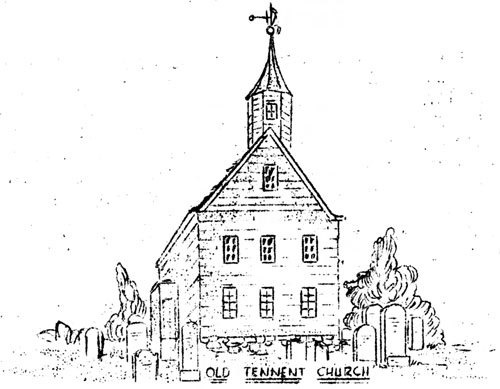|
Home : Quarterly Archives : Volume 3 |
Tredyffrin Easttown Historical Society |
|
Source: October 1940 Volume 3 Number 4, Pages 93–94 The Washington's Crossing trip There were twenty people in the motorcade which left the home of the secretary, Mildred Bradley, on August 11. The first objective was the spot along the Delaware River where General Washington and his brave soldiers, in preparation for their march on Trenton, crossed from the Pennsylvania to the Jersey shore Christmas night of 1776. The second objective was historic Freehold in Monmouth County, N.J., where the battle of Monmouth was fought June 28, 1778. Many historic places could be noted only in transit - Hatboro, colonial hat factory and scene of the Battle of Crooked Billet, the site of John Fitch's experiment on the steamboat at the junction of the Old York Road and the Street Road at Warminster, the house at Newtown in which General Washington prepared his report to Congress after the battle of Trenton. A main objective was reached when we approached Washington's Crossing State Park. In order to gain a general perspective of the river and the surrounding countryside, the first stop was made on the top of Bowman's Hill, where an observation tower of native stone has been erected. The north side of the hill and from thence to the river in the same direction has been set aside as a wild flower preserve. This spot, comprising 100 acres, is worthy of a day's trip. There are more than two miles of trails. Three hundred forty-seven species of ferns, shrubs and wildflowers native to Pennsylvania have been marked for identification. From the tower could be seen the Pidcock house where Lieut. Janes Madison, later President of the United States, had his quarters. To the south could be seen Loundes' or Taylor's Island, behind which some of the boats used in the crossing were hidden. After lunch beside the stream, we moved south to the McKonkey Ferry inn, where we crossed the river and stopped at the McKonkey Ferry House. It was at this point that the troops gathered before their march on Trenton. From this place they marched northeast two miles to Bear Tavern, where the entire array was split into two divisions, one under General Sullivan and the other under General Green, who was accompanied by General Washington.
McKonkey Ferry House The old Ferry House has been restored with furniture typical of the period. It must be seen to be appreciated. It might not be amiss, however, to mention a few items of interest, notably the bar, the bartender's beer mug with glass bottom, the fireplace with its appurtenances arranged in a most realistic fashion, the dining table whose top was one solid piece, and the chair table. In the rear of the house is a small replica of the garden at Mt. Vernon. Following the Lower River Road we made a forced march on Trenton and from there to Freehold. At Freehold we stopped at the Monmouth. County Historical Society, which is a museum. Here, there is early American furniture of fine craftsmanship, some of which was made in Philadelphia.
Old Tennent Church From the museum we took the road through the battlefield to the Old Tennent Presbyterian Church, which was used as a hospital during the battle of Monmouth. Along the road was a sign bearing the inscription, "Molly Pitcher's Well." Tradition tells, us that it was from this well that Molly Hayes carried water to her gunner husband. There seems to be, however, rather conclusive evidence that the well was not dug until after the battle, and that Molly obtained water from a nearby stream. Close to this spot is the place where Washington met Lee in his retreat and swore at Lee until the leaves of the tree shook. At least so says tradition. At the church, after roll call the caravan turned from history to provender. The majority willed that this could best be obtained at Asbury Park, sixteen miles distant. Once more a forced march was made, with a view of the ocean, a promenade on the boardwalk, and gathering around the festive board as the major objectives. With fulfillment of these objectives to the satisfaction of all, we wended our weary way homeward, filled with a deep pride in the accomplishments of our forebears in times of strife and adversity. - Donald L. Snively |

